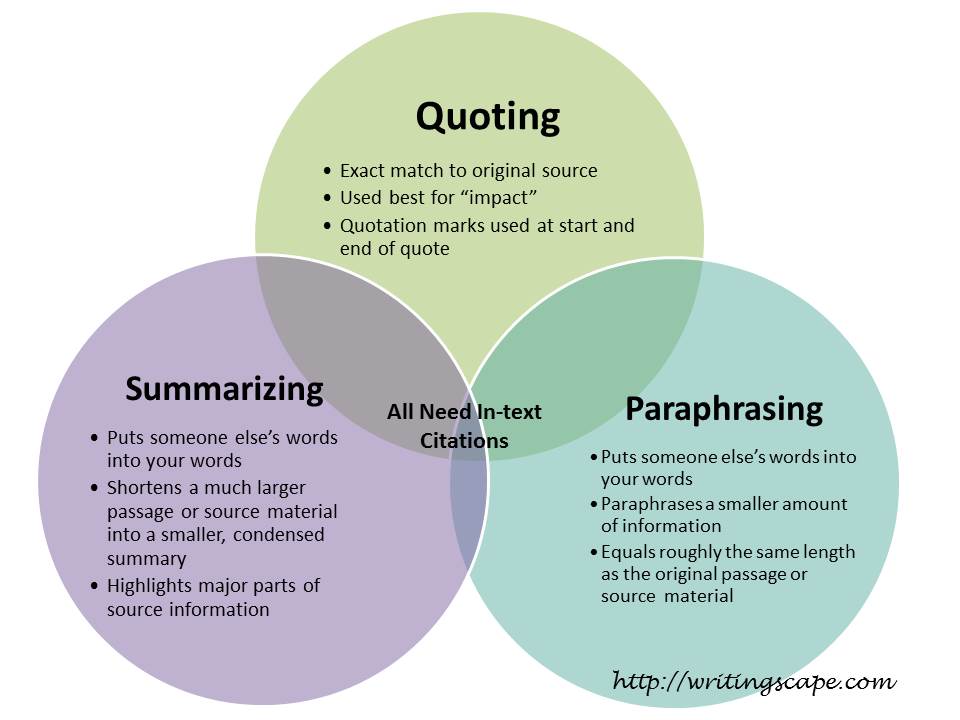What's in-text citing?
"In-text" means citing the source of information in the body of text, for example:
- In the text of an essay.
- In the outline of a speech.
- In a slide of a powerpoint.
Every time you cite a source in your text, there has to be a corresponding citation in the References page at the end of your essay or assignment.
General Information
Guidelines:
- Both direct quotations and paraphrases from other sources need a citation.
- All sources that are cited in text must also appear on the references page.
- Only cite the sources whose information you included within your paper.
- Use in-text citations sparingly; APA7 does not recommend over-citation.
- Cite all sources that are not common knowledge.
Parenthetical vs Narrative citation:
The parenthetical citation requires the author's last name and the date/year the work was published in parentheses (Author's last name, Year). Make sure to add the page number (if you have one) in parentheses if you are using a direct quote (Author last name, Year, p. #)
Narrative citation incorporates the author name and/or year in the narrative (as part of your sentence). Make sure to include the page number at the end in parentheses if you use a direct quote (p. #).
Examples:
Narrative: Huskin (2016) suggests that classroom activities that include writing help students stay engaged.
Narrative: In 2016, Huskin suggests that classroom activities that include writing help students stay engaged.
Parenthetical (paraphrase): Classroom activities that include writing help students stay engaged (Huskin, 2016).
Parenthetical (direct quote): “Writing activities increase students’ learning and engagement” (Huskin, 2016).
References Page:
Huskin, P. R. (2016). Engagement strategies for increasing student writing success. Education, 136(3), 283–290.
Citing Images in-Text
When citing images under the image in-text (including Powepoint slides):
Basic Format:
Figure X. An explanation or description of figure. Reprinted [or adapted] from Book Title (page number), by Author First Initial. Second Initial. Last Name, Year, Publisher.
Figure From a Website:
Figure X. Descriptive phrase that serves as title and description. Reprinted [or adapted] from Title of Website, by Author First Initial. Second Initial. Last Name, Year, URL.
Format Variations
Single Author:
(Author Last Name, Year)
Example:
“Writing activities increase students’ learning and engagement” (Huskin, 2016).
Two Authors:
(Author Last Name & Author Last Name, Year)
Examples:
(D'Amico & Barbarito, 2016) -parenthetical
D'Amico and Barbarito (2016) state... -narrative
*note: use the "&" in parenthetical citation, use "and" in narrative
Three and More Authors:
(Author Last Name et al., Year)
Examples:
(Landon et al., 2017). -parenthetical
Landon et al. (2017) write... -narrative
No Author:
*specifically for no author, for organization/owner as author, see next section below.
(Title, date) -parenthetical
Title (date) -narrative
Edited Book, No Author:
*For in-text citations, use editor names in place of author names.
(Editor Last Name & Editor Last Name, Year).
(Catapano & Critchley, 2016).
Chapter From Anthology:
*When citing chapter from anthology, use the chapter author as the author, not the editors.
(Chapter Author Last Name, Year).
(Glaspell, 2016).
Other Formats
Website:
Websites are cited the same as other sources in-text, in the (Author, Date format).
If no author, follow the below guidelines:
Many reliable resources published by the government, educational institutions or organizations do not have a specific author. In this case, the organization that published the resource becomes the author.
(Organization, date). -parenthetical
Organization (date) -narrative
(Center for Disease Control and Prevention [CDC], 2020).
*note: following citations of the same source can be shortened to (CDC, 2020).
Center for Disease Control and Prevention (CDC, 2020) ...
Lecture/Presentation:
(Presenter Last Name, Date)
Personal Communication
No personal communication is included in the Reference list
Example:
Dr. Phyllis Jackson (personal communication, October 1, 2016) felt the salt content in many canned soups was misleading to consumers. -narrative
OR:
Dr. Jackson felt the salt content in many canned soups was misleading to consumers (P. Jackson, personal communication, October 1, 2017). -parenthetical
NOTE: Personal Communications do not appear in the References page.
The APA Blog Style explanation in full is here.
